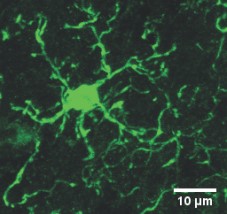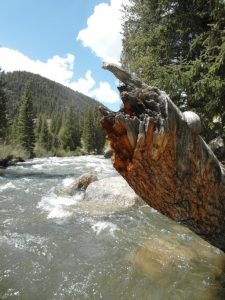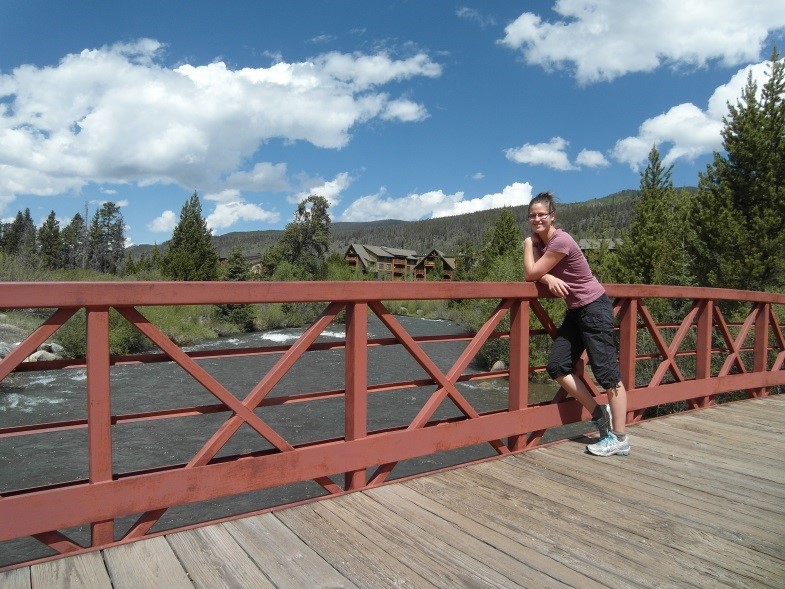
Maximum intensity projection of iba1-stained microglia (image: C. Schuy)
We as “microglia scientists“ work highly interdisciplinary. This is both exciting and challenging at the same time. We are neither neuroscience experts, nor immunology experts and this challenge becomes particularly apparent when you are planning to attend a conference. You have two possibilities: You can either attend neuroscience conferences, often together with a lot of electrophysiologists (Yes, I know: It is really great stuff they do, but you need to be an insider to fully understand it) or you meet all the immunologists, who like to talk about their T cells, B cells, DCs, … And if you are lucky you will sometimes find some talks on neuroinflammation or some neuroscientists, who at least recognize glial cells, which are as abundant in the brain as neurons are. All in all, I can interact a lot with these experts and it is, of course, quite useful to stay up to date in all their research topics because everything is somehow connected to microglia and my work. Still, I will never completely be part of these fields.
Microglia are important cells in the brain. They do a lot of great stuff: first, they refine the neural circuits by synaptic pruning from early development on, second they maintain the neuronal environment by cleaning up apoptotic material and third they are the “policemen of the brain”, watching out for invaders. Furthermore, evolving evidence demonstrates that microglia are important key players in many neurodegenerative diseases, like Alzheimer’s disease, Parkinson’s disease or schizophrenia.
Already a while ago, leading microglia specialists (e.g. Richard Ransohoff, Marco Prinz, Cornelius Gross) noticed that we, as microglia scientists, need our own meetings to develop the field and to be acknowledged in the community: The first meeting with focus on microglia was organized at the EMBL in Heidelberg in 2014. This meeting was such a great success that the idea came up to hold this event every two years either in Europe or in the US.
Back in 2014, I had just started my PhD and attended this great meeting in Heidelberg. It was a very inspiring and fascinating conference and pushed my PhD motivation even further. Thus, the following years I was always scanning for the follow-up meeting – and here it was: “Microglia in the Brain”, Keystone Symposium, June 12th-17th 2016. Again, all the important experts in the field were named on the speaker’s list and on top of this, it was a joint conference with “Common Mechanisms in Neurodegeneration”.

Joint symposia at Keystone, June 2016. (reproduced with permission of Keystone Symposia)
I absolutely wanted to attend that conference and also I had interesting data to share. The idea of getting some useful feedback, some new ideas or starting a collaboration to investigate things even further was tempting. So I convinced my boss that I urgently needed to go to Keystone. Thanks to the IITB travel grant from the ImmunoSensation Cluster of Excellence, it was much easier to convince him.

Wild Snake River near West Keystone (C. Schuy)
Finally at Keystone: In a beautiful high mountain environment I had the chance to talk to members of Beth Stevens’ lab, interacted with postdocs from Atlanta City, discussed methods with PhD students from Duke University, exchanged ideas with Canadian researchers, was introduced to other German microglia experts, … Especially the poster sessions were extensive and really interactive. It did not matter whether you were a professor, postdoc, graduate or undergraduate student. Everyone was discussing, questioning, discovering and advising. It was a lively, encouraging, and really friendly atmosphere.
There was always this spirit of “good-practice in scientific work” in the air. In particular, I liked the idea of close exchange of knowledge and collaboration to bring this emerging field successfully forward with combined forces. The more people exchange methods, ideas and resources, the more everyone will benefit from it. With this in mind and a bunch of new contacts, new ideas of experimental setups and new friends I just came back to the lab and look forward to start my work again J.
I highly recommend the Keystone symposia and for all of you who work on microglia: Don’t miss the next “Microglia-Meeting” in two years. See you there!

Me during my first walk along Snake River at Mountain House area (by C. Schuy)
Author: Christine Schuy

Pingback: The Alzheimer’s Association International Conference in Toronto – putting own research in a broader context – ImmunosensationBlog